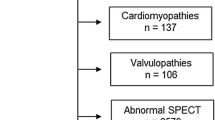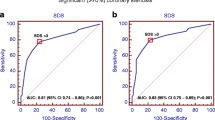Abstract
Dipyridamole stress is favorable in patients unable to exercise maximally for201Tl myocardial scintigraphy. Aside from an analysis of uptake defects, proper washout analysis can be limited by heart rate variations when isolated dipyridamole stress is used. Heart rate standardized201Tl washout kinetics after a combined dipyridamole and submaximal exercise stress protocol (CDSE), feasible in elderly patients as well as in patients with peripheral artery disease, were therefore studied to investigate the201Tl washout after CDSE in differently defined patient groups: Group I comprised 19 patients with documented heart disease and angiographically excluded coronary artery disease (CAD); group II contained 17 patients with a very low likelihood of CAD determined by both normal exercise radionuclide ventriculography and normal201Tl uptake. Group III comprised 56 patients with a 50% pretest likelihood of CAD but normal201Tl uptake. Mean washout values were nearly identical in all groups. Despite similar uptake patterns, however, washout standardized by CDSE was significantly lower than the normal washout values after maximal treadmill exercise. Thus an obviously lower201Tl washout after CDSE than after maximal treadmill exercise must be considered if washout analysis criteria after dipyridamole are applied to evaluate ischemic heart disease. Nevertheless, heart rate elevation achieved by additional submaximal exercise stress seems necessary, adequate and clinically safe for standardisation of washout analysis in dipyridamole201Tl scintigraphy.
Similar content being viewed by others
References
Albro PC, Gould KL, Wescott RJ, Hamilton GW, Ritchie JL, Williams DL (1978) Noninvasive assessment of coronary stenosis by myocardial imaging during pharmacologic coronary vasodilation: III. clinical trial. Am J Cardiol 42:751–760
Bateman TM, Maddahi J, Gray RJ, Murphy FL, Garcia EV, Conklin CM, Raymond MJ, Stewart ME, Swan HJC, Berman DS (1984) Diffuse slow washout of myocardial thallium-201: A new scintigraphic indicator of extensive coronary artery disease. J Am Coll Cardiol Vol 4, 55–64
Berger BC, Abramowitz R, Park CH, Desai AG, Madsen MT, Chung EK, Brest AN (1983) Abnormal thallium-201 scans in patients with chest pain and angiographically normal coronary arteries. Am J Cardiol 52:365–370
Boucher CA, Brewster DC, Darling RC, Okade RD, Strauss HW, Pohost GM (1985) Determination of cardiac risk by dipyridamole-thallium imaging before peripheral vascular surgery. N Engl J Med 312:389–394
Brown BG, Josephson MA, Petersen RB, Pierce CD, Wong M, Hecht HS, Bolson E, Dodge HT (1981) Intravenous dipyridamole combined with isometric handgrip for near maximal acute increase in coronary flow in patients with coronary artery disease. Am J Cardiol 48:1077–1085
Diamond GA, Forrester JS (1979) Analysis of probability as an aid in the clinical diagnosis of coronary-artery disease. N Engl J Med 1350–1358
Fridrich L, Pichler M, Gassner A, Vagner M, Mostbeck G, Eghbalian F (1985) Tracer elimination in I-123-heptadecanoic acid: half-life, component ratio and circumferential washout profiles in patients with cardiac disease. Eur Heart J [Suppl B] 6:61–70
Garcia E, Maddahi J, Berman D, Waxmann A (1981) Space/time quantitation of thallium-201 myocardial scintigraphy. J Nucl Med 22:309–317
Gill JB, Miller D, Boucher CA, Strauss W (1986) Clinical decision making: Dipyridamole thallium imaging. J Nucl Med 27:132–137
Gould KL (1978) Noninvasive assessment of coronary stenoses by myocardial perfusion imaging during pharmacologic coronary vasodilatation. Am J Cardiol 41:267–278
Gould KL, Westcott RJ, Albro PC, Hamilton GW (1978) Noninvasive assessment of coronary stenoses by myocardial imaging during pharmacologic coronary vasodilatation. Am J Cardiol 41:279–287
Iskandrian AS, Hakki A, Amenta A, Kane SA, Mattleman S, Edlin D (1984) Resting kinetics of thallium-201 in patients with coronary artery disease. Chest 86:213–218
Iskandrian AS, Hakki A-H (1985) Thallium-201 myocardial scintigraphy. Am Heart J 109:113–129
Josephson MA, Brown BG, Hecht HS, Hopkins J, Pierce CD, Petersen RB (1982) Noninvasive detection and localization of coronary stenoses in patients: Comparison of resting dipyridamole and exercise thallium-201 myocardial perfusion imaging. Am Heart J 103:1008–1018
Kaul S, Chesler DA, Pohost GM, Strauss W, Okada RD, Boucher CA (1986) Influence of peak exercise heart rate on normal thallium-201 myocardial clearance. J Nucl Med 27:26–30
Lear JL (1986) Effect of exercise position during stress testing on cardiac and pulmonary thallium kinetics and accuracy in evaluating coronary artery disease. J Nucl Med 27:788–794
Leppo JA, O Brien J, Rothendler JA, Getchell JD, Lee VW (1984) Dipyridamole-thallium-201 scintigraphy in the prediction of future cardiac events after acute myocardial infarction. N Engl J Med 310:1014–1018
Lowe DK, Rothbaum DA, Mc Henry PL, Corya BC, Knoebel SB (1975) Myocardial blood flow response to isometric (handgrip) and treadmill exercise in coronary artery disease. Circulation 51:126–131
Nitenberg A, Foult JM, Kahan A, Perennec J, Devaux JY, Menkes CJ Amor B (1986) Reduced coronary flow and resistance reserve in primary scleroderma myocardial disease. Am Heart J 112:309–315
O'Byrne GT, Maddahi J, Van Train KF, Wong C, Ramsdale I, Friedman JD, Berman DS (1986) Myocardial washout rate of Thallium-201: Comparison between rest, dipyridamole with and without aminophylline, and exercise states. J Nucl Med 27:943 (abstr)
Reisman S (1985) Dipyridamole thallium testing: An alternative form of stress testing in patients unable to exercise. Chest 88:321–322
Rozanski A, Diamond GA, Jones R, Forrester JS, Berman D, Morris D, Pollock BH, Freeman M, Swan HJC (1985) A format for integrating the interpretation of exercise ejection fraction and wall motion and its application in identifying equivocal responses. J Am Coll Cardiol 5, 238–248
Ruddy T, Dighero H, Newell J, Pohost G, Strauss W, Okada R, Boucher C (1987) Quantitative analysis of dipyridamolethallium images for the detection of coronary artery disease. J Am Coll Cardiol 10:142–149
Sorensen SG, Groves BM, Horwitz LD, Chaudhuri TK (1985) Regional myocardial blood flow in man during dipyridamole coronary vasodilatation. Chest 87:735–739
Siostrzonek P, Dudczak R, Schmoliner R (1987) Reproductibility of myocardial Thallium-201 washout in studies applying a standardized dipyridamole stress protocol. Clin Cardiol 10:334–340
Van Train KF, Berman DS, Garcia EV, Berger HJ, Sands MJ, Friedman JD, Freeman MR, Pryzlak M, Ashburn WL, Norris SL, Green AM, Maddahi J (1986) Quantitative analysis of stress thallium-201 myocardial scintigrams: A multicenter trial. J Nucl Med 27:17–25
Walker PR, James MA, Wilde RP, Wood CH, Russel Rees J (1986) Dipyridamole combined with exercise for thallium-201 myocardial imaging. Br Heart J 55:321–329
Wackers FJ, Fetterman RC, Mattera JA, Clements JP (1985) Quantitative planar thallium-201 stress scintigraphy: A critical evaluation of the method. Sem Nucl Med 1:46–66
Wilson RF, White CW (1986) Intracoronary papaverine: an ideal coronary vasodilator for studies of the coronary circulation in conscious humans. Circulation 73:444–451
Ziada G, Muhammad MM, Bahar RH, Abdel-Dayem HM (1985) Background subtraction in quantitative myocardial thallium-201 analysis: Normal volunteers study. Nuc-Compact 16:285–290
Author information
Authors and Affiliations
Rights and permissions
About this article
Cite this article
Fridrich, L. Myocardial201Tl washout after combined dipyridamole submaximal exercise stress: Reference values from different patient groups. Eur J Nucl Med 15, 81–86 (1989). https://doi.org/10.1007/BF00702624
Received:
Accepted:
Issue Date:
DOI: https://doi.org/10.1007/BF00702624




